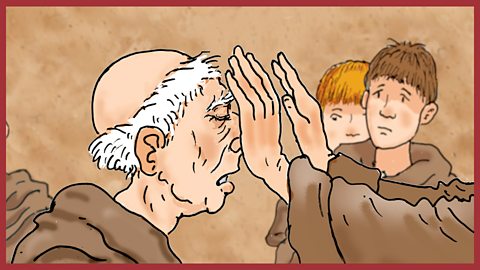In short...
Themes: celebrating St Valentine's Day; the life of St Valentine; customs associated with St Valentine's Day; saints.
Summary: This assembly celebrates St Valentine's Day, which falls on 14 February each year. The video animation explores what we know about the 'real' St Valentine: he is believed to have been a priest-cum-doctor living in the 3rd Century at the time of the Roman Empire who married Roman soldiers against the wishes of Emperor Gothicus. The assembly is particularly suitable in the days preceding St Valentine's Day, or used in conjunction with our other content exploring the lives of well-known saints.
Resources: The , an illustration posing the question and an illustration showing .

The video
ST VALENTINE’S DAY
Every year on the 14 February we celebrate Valentine’s Day. Most people celebrate by giving a card to someone special they care about. Or by giving gifts, like chocolate and flowers. And that’s why St Valentine is known as 'Patron Saint of Love'.
But did you know there are actually lots of St. Valentines? There’s St Valentine of Genoa…or St Valentine of Rhaetia…and even St Valentina of Palestine.
Our St Valentine is the one and only St Valentine of Rome, Patron Saint of Love. Though he’s also the patron saint of people with epilepsy…and beekeepers.
And if you think that’s confusing, it’s not really clear how much of the story of St Valentine - St Valentine of Rome - is actually true.
The most popular story is that Valentine was a Roman priest and doctor, who lived in the 3rd Century.
Around that time the Roman Emperor, Claudius Gothicus, banned Roman soldiers from getting married. Gothicus loved war and spent most of his time fighting on the edges of the Empire. He believed that marriage distracted his soldiers from war and made them soft.
But Valentine was brave and stood up for the soldiers, helping them to get married in secret. Although this was a kind act, it was very risky.
For many years Valentine also worked in Roman hospitals. He spent his days treating patients with terrible war wounds and diseases, like plague and smallpox…and his nights performing secret marriages for grateful soldiers in love.
But Emperor Gothicus soon found out about Valentine’s secret weddings. He was furious and had Valentine arrested and thrown in jail.
Now in prison, Valentine couldn’t help the soldiers anymore.
The story goes that he was placed under the watchful eye of Asterius the jailer. Asterius only believed in Roman gods and didn’t like Christians, like Valentine, at all.
Asterius had a daughter called Julia, who was blind. So he challenged Valentine to pray to his Christian god and restore her eyesight.
So, Valentine placed his hands gently on Julia’s eyes, prayed to God, and suddenly she could see again!
Asterius was shocked! As a thank you, he freed Valentine and all the Christians in his prison.
But Emperor Gothicus soon found out about Asterius’ change of heart.
Even angrier than he was before, he announced that Asterius and Valentine would both die.
Before he was taken to be executed, Valentine wrote a goodbye letter to Julia. He signed the letter ‘From your Valentine’. It was 14 February and so the letter became the very first Valentine’s Day letter in history.
The story of St Valentine was passed down through the centuries and is even featured in the work of the famous English poet, Geoffrey Chaucer, in the 1300s…and William Shakespeare, over two hundred years later.
When postage stamps were introduced in the 19th Century, people were able to send letters and cards cheaply and reliably and anonymously - which means the person receiving the letter doesn’t know who sent it.
It became so popular that factories all over the world had to begin producing millions of Valentine’s cards each year.
And that’s why on 14 February we celebrate Valentine’s Day by writing cards to our loved ones, just like Saint Valentine did all those years ago.
Each year on 14 February we celebrate St Valentine's Day by giving our loved ones cards or gifts, such as flowers or chocolates. But who was Valentine and what do we know of him?
It is believed Valentine was a priest living in the 3rd Century at the time of the Roman Empire. The Roman Emperor - Claudius Gothicus - banned his soldiers from getting married, because he felt marriage was a distraction from fighting. But Valentine continued to marry Roman soldiers in secret.
When Gothicus found out Valentine was thrown in jail. The story continues that the jailer had a daughter who was blind, but Valentine was able to restore her sight by praying to his Christian God. The jailer released Valentine, but when Gothicus found out both Valentine and the jailer were sentenced to death.
On 14 February Valentine wrote a farewell letter to the jailer's daughter - the very first Valentine's Day letter.
Duration: 3' 54"
End of speech: '…just like St Valentine did, all those years ago.'
Video questions
- St Valentine is Patron Saint of Love…and what else? (People with epilepsy; beekeepers)
- Where and when did St Valentine live? (In Rome in the 3rd Century)
- Why did the Roman Emperor ban soldiers from getting married? (He thought marriage was a distraction from making war)
- Why did the jailer not like Valentine? (Because he believed in Roman gods and Valentine was a Christian)
- What did Valentine do on 14 February? (He wrote a farewell letter to Julia, the jailer's daughter)
- What does doing something anonymously mean? (Doing something without being identified)
- St Valentine features in the work of which two English poets that are mentioned? (Geoffrey Chaucer and William Shakespeare)

Key links
Download / print the assembly framework ready for use
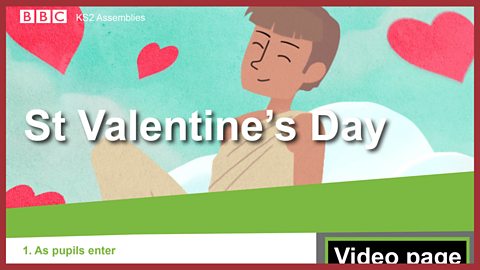
Click to display the image full-size

Love means... A group of primary school children say what the word 'love' means to them
LOVE MEANS…
Love means to me friendship and kindness to people…
Love means to me that you should be calm and never hurt anybody…
Love is enjoying spending time with someone…
Love means to me kindness and to never bully or hurt somebody's feelings…
Love to me means kind and helpful…
Love is being with someone that you care about…
Click to display the image full-size
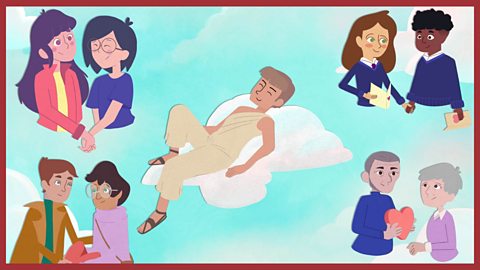

Suggested framework
1. Entry
Play your chosen music and display a focus image if you wish to (see Key links).
2. Introduction
Begin with some questions on the theme of love, before moving on to St Valentine:
- What does the word 'love' mean to you and who do you love? Who loves you? (You could play the short video 'Love means…' - see Key links above).
- If you had to chose one idea to finish the statement 'Love is…' what would it be?
- What happens on St Valentine's Day?
- Do you think Valentine was a real person? Who do you think Valentine may have been?Explain that now everyone is going to watch a short animation about who the 'real' St Valentine was.
3. Play the video
The duration is 3' 54" and the final words are: '…just like St Valentine did, all those years ago.'
4. After the video - time to talk
You could ask some or all of the Video questions to consolidate pupils' recall and understanding of the film:
- St Valentine is Patron Saint of Love…what is a 'patron saint'? (A saint with a special connection to either a particular place or a particular community of people)
- Where and when did St Valentine live? (In Rome in the 3rd Century)
- Why did the Roman Emperor ban soldiers from getting married? (He thought marriage was a distraction from making war)
- Why did the jailer not like Valentine? (Because he believed in Roman gods and Valentine was a Christian)
- How was Valentine able to use his Christian faith? (He was able to heal the eyesight of the jailer's daughter, Julia)
- What did Valentine do on 14 February? (He wrote a farewell letter to Julia)
- What does doing something anonymously mean? (Doing something without being identified)
5. Opportunity to sing
An opportunity to include your chosen song. Suggestions from 91»»±¨ collections below.
6. Opportunity to reflect
Now it's time to be quiet and think about some of the things we've heard about today…
We've been thinking about St Valentine's Day and the word 'love'…
We've seen that a Valentine's Day card can be a fun way to tell someone else that you care for them…even if you don't actually say who you are…
Love is a powerful thing…it can make a very special bond between people… friends… families… communities…
Think for a moment about the people who are most important to you… friends… family… class-mates… teachers…
Think of ways that you can show that you care for them…
7. Opportunity for prayer
Begin with your usual form of address ('Dear God', 'Let us pray', etc) and:
Thank you for all the people that are important to us.
Help us to show them what they mean to us.
And help everyone to feel cared for.
Amen.

Suggested songs
Song: 'Chain of love' (All about our school, no 14. Vocal version)
- For the children of tomorrow
We’ve got to make it a better place,
Fill the world with love and laughter,
Make a fresh start for the human race.
(Chorus)
Chain of love, chain of love,
Circle the world with a chain of love,
Chain of love, chain of love,
Circle the world with a chain of love.
- No more war and no more hunger,
No more jealousy and hate,
Say goodbye to greed and sadness,
Make a change now or it will be too late.
(Chorus)
(Middle eight)
Circle the world, circle the world,
Circle the world, circle the world.
- Doesn’t matter where you come from,
Doesn’t matter where you’ve been,
Different race or creed or colour,
We are the same underneath our skin.
(Chorus)
Chain of love, chain of love,
Circle the world with a chain of love,
Chain of love, chain of love,
Circle the world with a chain of love.
Circle the world with a chain of love.
Song: 'Being a friend' (All about our school, no 8. Vocal version)
Being a friend is the best thing you can be,

‘Cos in the end friends are something we all need.
You could score a goal for England,‚Ä®
Be a pop star on TV,

But being a friend

Is still the best thing you can ever be.
Being a friend is the best thing you can do,‚Ä®
Time and again it’s our friends that help us through.
You could be a millionaire,‚Ä®
Or fly a rocket to the moon,

But being a friend

Is still the best thing you can ever do.
Whatever we grow up to be,
And live in harmony,
Together we all need to see
That friendship is the key!
Being a friend is the best thing you can be,‚Ä®
‘Cos in the end friends are something we all need.
You could score a goal for England,

Be a pop star on TV,

But being a friend‚Ä®
Is still the best thing you can ever be.
Being a friend

Is still the best thing you can ever be.
Song: 'Peace is flowing' (Come and Praise, no 144. Vocal version)
Peace is flowing like a river,
Flowing out through you and me,
Spreading out into the desert,
Setting all the people free.Love is flowing like a river,
Flowing out through you and me,
Spreading out into the desert,
Setting all the people free.Joy is flowing like a river,
Flowing out through you and me,
Spreading out into the desert,
Setting all the people free.Hope is flowing like a river,
Flowing out through you and me,
Spreading out into the desert,
Setting all the people free.

Other assemblies about patron saints
St George's Day. collection
KS1 / KS2. Celebrating St George's Day (23 April); the life of St George; saints; courage.
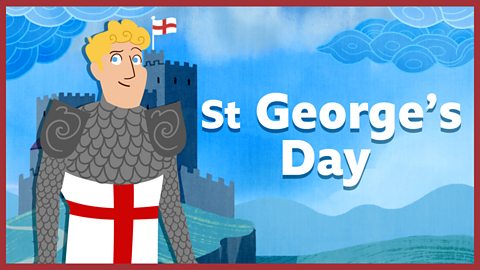
St Patrick's Day. collection
KS1 / KS2. Celebrating St Patrick's Day; the life of St Patrick; showing courage and determination.
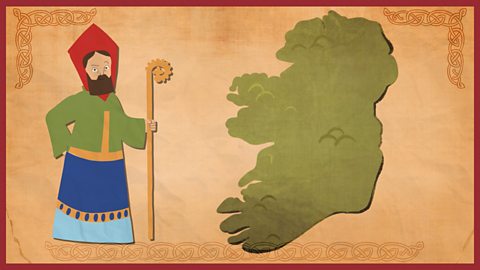
St David's Day. collection
KS1/KS2. Celebrating St David's Day (1 March); patron saints; the life of St David; devotion.
